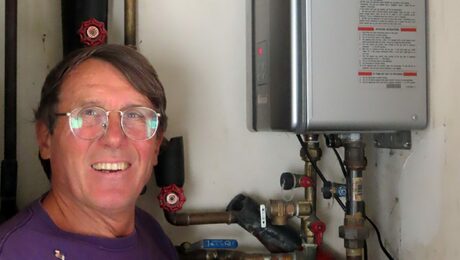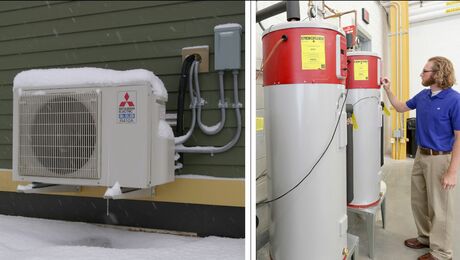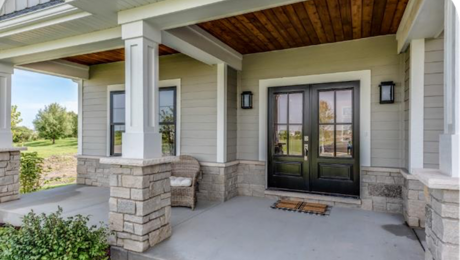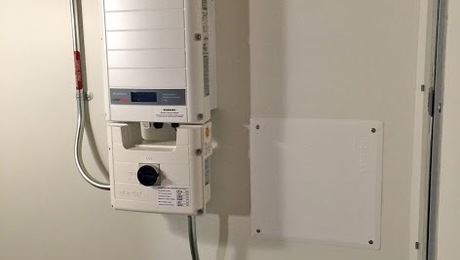Calculating the Heating Load for a Minisplit System
Hi everyone,
I was wondering if some of you could help me clarify the heating load for a mini-split system. I recently moved into a 1900 sq ft one-hundred-year-old house in southern Connecticut (I don’t know what climate zone – every time I try to figure it out, I only get info on “plant hardiness” zones). We have natural gas to hydronic radiator heat now, but my rough plan is to put Mitsubishi hyper-heat mini-splits on the first floor and hydronic electric baseboard radiators (plus window-unit ACs in the summer) in the bedrooms on the second floor. We just put in an 8 kW solar array that produces roughly 10,000 kWh a year (we have net metering credits too). Total annual kWh usage in the house right now is roughly 6,400 kWh, so we have an extra 3,600 kWh per year of solar production that we could use for heating and cooling. The only gas use in the house is for: space heating (gas boiler to radiators) and the stove. My ultimate goal is to electrify everything in the house and completely remove all gas appliances and hook-ups. So when we put in hyper-heat minisplits (downstairs) and electric hydronic radiators (upstairs), I’m hoping that this can handle 100% of the heating load and that we won’t need the gas boiler as a backup.
The first floor is a 5×5 foyer, a 25×13 living room, a 13×13 dining room, a 14×14 kitchen, an 11×16 bedroom, and an 11×10 bathroom (the bathroom and bedroom are connected — total downstairs sq ft is 1,001). My original plan was to put three hyper-heat units in the downstairs (of whichever btu capacity makes sense): one in the living room, one in the dining room, one in the bedroom. Though recently, I’ve wondered whether it makes financial sense to put a minisplit in the bedroom — we’re using it as a guest bedroom/playroom for our toddler, but it only gets used for about an hour a day on average, so it might cost less overall money to heat and cool it with baseboards and a window unit AC during the hour or so that we’re in there rather than paying for the extra minisplit and then “setting and forgetting” the temp to a constant 68F. My reason for putting baseboards and window units upstairs is similar: the three upstairs bedrooms are smallish (100 – 150 sq ft each), as is the hallway (25 sq ft) and the upstairs bathroom (25 sq ft). So it seems like baseboards and window units, energy hogs that they are, would still be more economical than doubling the total installed cost of a minisplit system by adding a whole second floor to the project.
Anyway, I’ve been trying to calculate our heating load using the method outlined in Dana Dorsett’s “Out With the Old, In With the New.” This is what I came up with using a mid February to mid March gas bill:
2/16/21 – 3/17/21 gas bill (29 days): 192 ccf of usage
192 ccf = 199.104 therms = 19,905,647.18 BTUs
Boiler: Burnham Series 2 — 82% efficiency
19,905,647.18 x .82 = 16,322,630.6 BTUs
According to degreedays.net, in my area:
65F degree days in February 2021: 960
65 F degree days in March 2021: 730
Average 65F degree days in my area: 845 (the website wouldn’t let me input the specific dates in my gas bill, so the best I could do was average the February and March numbers to come up with an approximation for 2/16-3/17 degree days).
60F degree days in Feb: 820
60F degree days in March:579
Average: 699.5
16,322,630.6/845 = 19,316.72 BTUs per 65 degree day/24 hours = 804.86 BTUs per degree hour
16,322,630.6/699.5 = 23,334.71 BTUs per 60F degree day/24 hours = 972.28 BTUs per degree hour
99% outside design temperature: 2 degrees F
(65F-2F) x 804.86 BTU/hr = 50,706.18 BTU/hr for whole house gas use (gas stove plus gas heating for the first and second floors) from Feb 16, 2021- March 17, 2021
(60F-2F) x 972.28 BTU/hr = 56,392.24 BTU/hr for whole house gas use (gas stove plus gas heating for the first and second floors) from Feb 16, 2021 – March 17, 2021
Just to be conservative, let’s say we go with the higher number: 56,392.24 BTU/hr
56,392.24 x 1.4 ASHRAE oversizing factor = 78,949.136 BTU/hr
But then here are some things I’m struggling with:
1. I don’t totally know how to quantify how much of this is for the gas stove. It probably gets used for an average of 30 minutes per day, 7 days a week. So then maybe 10% of our total monthly gas use is for the stove? 5%? (This is basically a guess).
2. When we moved into the house, there was zero insulation in the attic. We had an insulation company add R-49 (blown in cellulose under the attic floorboards plus fiberglass batts on top of the floorboards) on March 4th, but they forgot to insulate the attic fan, which I was told (by a second insulation company that insulated the attic fan for us on April 14) lowered the total R value of the attic to R-15. So essentially, for most of the billing period in the above gas bill, we had no attic insulation, and only for the final 10 days of the period did we have R-15 in the attic.
3. Our house has two heating zones. One zone is the first-floor bedroom/bathroom. The other is the whole rest of the house (the rest of the downstairs plus the entire upstairs). In the main heating zone, we tend to set the thermostat to 70F for 30-60 minutes once or twice a day depending on how cold it is, and then we set the thermostat down to 60F and let the temperature in the house drop. In the second heating zone (the downstairs bedroom/bathroom only), the thermostat is mostly set to 50-55F. The room has extremely drafty/failing single-pane windows that we’re going to replace in the next few weeks, so we mostly close the door to this room during the 23 hours per day that we’re not using it, and leave the thermostat in there set to 50-55F.
Anyway, the 199 therms that we used during the billing period was for gas cooking, plus 1-2 hours of heat per day in the main heating zone (keeping most of the house between 60-70F), plus keeping the second heating zone (one bedroom/bathroom) above 50-55F.
So then how to calculate the total heating load given all of the above?
If the gas stove is 10% of the gas use then 78,949.136 x .9 = 71,054.22 BTU/hr heating load for whole house (before the attic was insulated)
If insulating the attic from R-0 to R-49 reduced the heating load by 30% (another total guess), then 71,054.22 x.7 = 49,737.95 BTU/hr heating load for whole house (after the attic was insulated to R-49)
If the downstairs is roughly 1,000 sq ft and the upstairs is roughly 500 sq ft (not including the closets, staircase, and upstairs hall), then the downstairs should be roughly 2/3 of the total house heating load so 49,737.95 x .67 = 33,158 BTU/hr downstairs-only heating load**
Does this seem accurate? Any major or minor problems with the math, or other things I haven’t considered?
(I haven’t been able to find anyone locally who is willing to do a Manual-J.)
**This of course assumes that the first-floor bedroom/bathroom would continue to be set to 50-55F most of the day, and only turned to 70F for an hour per day on average. Since it’s not practical to use a heat pump like this (because it takes longer for heat pumps to raise the temperature of the room), a minisplit in this bedroom would mean “setting and forgetting” at 68F or so. But would this be likely to increase or decrease the overall BTU/hr heating load required for the first-floor? In other words, what takes more BTUs/hr: using radiators to maintain the room at 55F 23 hours and day, and turn the temp to 70F for one hour a day, or using a heat pump set to a constant 68F?
If you are still reading this, bless you. Any insights that anyone could offer would be much appreciated. Thanks.
GBA Detail Library
A collection of one thousand construction details organized by climate and house part









Replies
You say that natural gas is only used for space heating and cooking. What about your domestic hot water? Is that provided by your boiler? If so, perhaps ten to fifteen per cent of your total consumption can be attributed to this purpose.
If you’re talking about 3 mini split units for 1000 sq ft on the main level - that sounds massively oversized.
Keep in mind, in the winter, any heat generated downstairs is going upstairs eventually. I have 2 mini split units on my lower lever and 1 on the upper level. I don’t even run the upstairs unit in the winter, the downstairs units heat the whole house.
I’d suggest using coolcalc to run a j calc to the best of your knowledge and then working from that with aggressive numbers.
You should attempt the Manual J at https://www.coolcalc.com/
Hot water is electric.
The original reason for 3 minisplits was not to meet a certain capacity of BTUs but to make sure there is enough airflow - to make sure hot and cold air are reaching the whole downstairs. But I could conceivably go down to 2.
I will check out cool calc. But any thoughts on what I’ve written above?
I’m not going to lie, I skimmed. That’s a lot of info. I think you might be overthinking it. Calculate your load with a manual J on coolcalc. Work from aggressive numbers and size from there. Mini splits can throw air crazy distances. I have a 2500 sq ft ranch style home and a single mini split head unit will throw air horizontally from one side all the way to the other. Seal your envelope well enough and the conditioned air will navigate corners just as well. Don’t worry about heat upstairs, the downstairs unit will rise perfectly well. Size your upstairs unit for the cooling load. Just my opinion, but I’ve installed a handful of Mitsubishi mini split systems and they all have happy occupants. I also have them in my own personal home, and it’s 100+ years old.
Agree that this appears to be overthinking the problem. There's just too many variables and unknowns.
Also agree with your plan for the upstairs, heating each room with electric heat. With thermostats for each separate space, you can only heat the space when needed, and adjust the temp to whatever is comfortable for the occupant. As you improve your building's shell to reduce heat loss, you can adjust room heating easily. And its relatively cheap to install the individual electric resistance or radiant heaters and thermostats (especially if the heater includes the thermostat), $35 and up. This might be a better solution downstairs as well, vs. installing more than a single mini split.
You might try using a cheap portable space heater to measure how much heat is needed in any of the rooms you can close off, to get an estimate of the amount of heat needed given the outdoor temp at the time? Might yield a better approximation than the more complex analysis of gas costs.
Use the attached for climate zone information.
With hydronic systems in place, you may want to replace the natural gas boiler with an air to water heat pump which is all electric and can have high Coefficient of Performance (COP). Energy Vanguard uses Wright soft and they could give you a quote.
I would also watch some John Siegenthaler videos on You Tube. He goes through some issues when replacing natural gas boilers.
Well, I do have extremely oversized cast iron radiators in the upstairs bedrooms. I’ve been told they’re twice the size as what’s necessary for the heat load in those bedrooms — they’re 2 ft tall and 5 ft long, and the rooms they’re in are only 100-150 sq ft each. But don’t air to water heat pumps not get hot enough for cast iron radiators?
I've always just looked at my gas use when there's no heating use, and gone off of that approximate number. So what are you using for gas in June/July/Aug......Bingo, there's your cooking use.
Good idea. I can do this now, this spring and summer, since we just replaced our gas water heater with a HPWH in January. But the problem at the moment is that all the warm weather gas usage from last summer includes hot water heating.....
I've been looking into air to water heat pumps for the last few days. I'm intrigued, because it would mean we don't have to rip out our 100 year old radiators. I would also prefer radiator heat to forced hot air, but I didn't know air to water heat pumps were really viable. But I'm really uninformed about all this so I have some basic/sort of ignorant questions:
1. Since I already have a gas boiler which sends hot water to baseboard radiators on the first floor and upright cast iron radiators on the second floor, can I just swap out the gas boiler for an air to water heat pump + some of kind of buffer water tank and then that's it? Or would there be all kinds of re-piping required? (Let's say I don't need the system to do cooling, just heating, to keep it simple).
2. Assuming it's more or less as simple as described above, my limited understanding is that our first-floor baseboard radiators don't have the surface area to effectively give off enough heat at the 120-140F water supplied by the AWHP, but that our extremely oversized 5 ft long by 2 ft tall upright cast-iron radiators in our three small upstairs bedrooms (100-150 sq ft each) would give off enough heat. (In fact, connected as they are right now to our gas boiler, they give off way too much heat and we have to leave them completely off most of the time if we don't want the upstairs to be 80F all the time.) Is this true?
3. If this is true, what about a heating system where I use air to air minisplits for the first floor and an air to water heat pump for the second floor? Or attempt to use the air to water heat pump for the whole house, but install one air to air minisplit on the first floor that can assist the air to water heat pump wherever/whenever it's lagging?
4. What are the best brands of air to water heat pumps these days? The LG Therma V looks very good but for some reason is not offered in the US? Otherwise, Nordic, Artic, Chiltrix, etc?